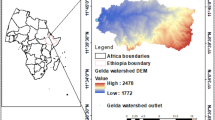Abstract
Assessment of erosion status of a watershed is an essential prerequisite of integrated watershed management. This not only assists in chalking out suitable soil and water conservation measures to arrest erosion and conserve water but also helps in devising best management practices to enhance biomass production in watersheds. The geologic stages of development and erosion proneness of the watersheds are quantified by hypsometric integral. The estimation of hypsometric integral is carried out from the graphical plot of the measured contour elevation and encompassed area and by using empirical formulae. In this study, efforts were made to estimate the hypsometric integral values of the Sainj and Tirthan watersheds and their sub watersheds in the Lesser Himalayas using four different techniques, and to compare the procedural techniques of its estimation and relevance on erosion status. It was revealed that the hypsometric integral calculated by elevation–relief ratio method was accurate, less cumbersome and easy to calculate within GIS environment. Also comparison of these hypsometric integral values revealed that the Sainj watershed (0.51) was more prone to erosion than the Tirthan watershed (0.41). Further, the validation of these results with the recorded sediment yield data of 24 years (1981–2004) corroborated that the average annual sediment yield during this period for Sainj watershed (0.53 Mt) was more than that of the Tirthan watershed (0.3 Mt). Thus, the hypsometric integral value can be used as an estimator of erosion status of watersheds leading to watershed prioritization for taking up soil and water conservation measures in watershed systems.
Similar content being viewed by others
References
Awasthi KD, Sitaula BK, Singh BR, Bajacharaya RM (2002) Land-use changes in two Nepalese watersheds: GIS and geomorphometric analysis. Land Degrad Dev 13:495–513
BBMB (Bhakra Beas Management Board) (1997) Sedimentation survey report. BBMB, Bhakra Dam Circle, Nangal, India
Bishop MP, Shroder JF, Bonk R, Olsenholler J (2002) Geomorphic change in high mountains: a western Himalayan perspective. Glob Planet Change 32:311–329
Dabral PP (2003) Hypsometric analysis of Dikrong River basin of Arunachal Pradesh. J Soil Water Conserv India 2:97–100
Dowling TI, Richardson DP, O’Sullivan A, Summerell GK, Walker J (1998) Application of the hypsometric integral and other terrain based metrices as indicators of the catchment health: a preliminary analysis. Technical report 20/98. CSIRO Land and Water, Canberra
Garg SK (1983) Geology—the science of the earth. Khanna, New Delhi
Goel AK, Singh JK (2000) Hypsometric analysis for foothills of Shivaliks. Indian J Soil Conserv 28:84–85
Harrison CG, Miskell KJ, Brass GW, Saltzman ES, Sloan JL II (1983) Continental hypsography. Tectonics 2:357–377
Hurtrez JE, Sol C, Lucazeau F (1999a) Effect of drainage area on hypsometry from an analysis of small-scale drainage basins in the Siwalik hills (Central Nepal). Earth Surf Processes Landf 24:799–808
Hurtrez JE, Lucazean F, Lave J, Avouac JP (1999b) Investigation of the relationship between basin morphology, tectonic uplift and denudation from the study of an active fold belt in Siwalik hills (Central Nepal). J Geophys Res 104:779–796
Jain SK, Kumar S, Varghese J (2001) Estimation of soil erosion for a Himalayan watershed using GIS technique. Water Resour Manag 15:41–54
Jain SK, Singh P, Saraf AK, Seth SM (2003) Estimation of sediment yield for a rain, snow and glacier fed river in the western Himalayan region. Water Resour Manag 17:377–393
Langbein WB (1947) Topographic characteristics of drainage basins. U.S.G.S. Water Supply Paper 968C:127–157
Mishra N (1988) Hypsometric integral—a basis for determining the erosion status and priority number of ungauged watershed. J Soil Water Conserv 32:38–45
Ohmori H (1993) Changes in the hypsometric curve through mountain building resulting from concurrent tectonics and denudation. Geomorphology 8:263–277
Pandey A, Chowdary VM, Mal BC (2004) Hypsometric analysis of watershed using geographic information system. J Soil Water Conserv India 3:123–127
Pike RJ, Wilson SE (1971) Elevation–relief ratio, hypsometric integral and geomorphic area–altitude analysis. Geol Soc Amer Bull 82:1079–1084
Pradhan K, Senapati PC (2002) Hypsometric analysis of some selected watersheds of Hirakund catchment. J Soil Water Conserv 30:183–185
Rao VV, Chakraborti AK, Vaz N, Sarma U (1994) Watershed prioritization on sediment yields modeling and IRS-1A LISS data. Asian Pacific Remote Sensing Journal 6:59–65
Ritter DF, Kochel RC, Miller JR (2002) Process geomorphology. McGraw Hill, Boston
Rosenblatt P, Pinet PC (1994) Comparative hypsometric analysis of Earth and Venus. Geophys Res Lett 21:465–468
Sarangi A, Bhattacharya AK (2000) Use of geomorphological parameters for sediment yield prediction from watersheds. J Soil Water Conserv 44:99–106
Sarangi A, Bhattacharya AK, Singh A, Singh AK (2001) Use of geographic information system (GIS) in assessing the erosion status of watersheds. Indian J Soil Conserv 29:190–195
Sarangi A, Madramootoo CA, Singh DK (2004) Development of ArcGIS assisted user interfaces for estimation of watershed morphologic parameters. J Soil Water Conserv 3:139–149
Schumm SA (1956) The evolution of drainage systems and slopes in badlands at Perth Amboy, New Jersey. Geol Soc Amer Bull 67:597–646
Strahler AN (1952) Hypsometric (area–altitude) analysis of erosional topography. Geol Soc Amer Bull 63:1117–1141
Strahler AN (1964) Quantitative geomorphology of drainage basins and channel networks. In: Chow VT (ed) Handbook of applied hydrology. McGraw Hill, New York
Todd G, Paul P, Smith G, Atkins A (1997) Estimating the economic costs of hydrologic data collection. Water Resour Manag 11:283–303
Weissel JK, Pratson LF, Malinverno A (1994) The length-scaling properties of topography. J Geophys Res 99:13997–14012
Author information
Authors and Affiliations
Corresponding author
Rights and permissions
About this article
Cite this article
Singh, O., Sarangi, A. & Sharma, M.C. Hypsometric Integral Estimation Methods and its Relevance on Erosion Status of North-Western Lesser Himalayan Watersheds. Water Resour Manage 22, 1545–1560 (2008). https://doi.org/10.1007/s11269-008-9242-z
Received:
Accepted:
Published:
Issue Date:
DOI: https://doi.org/10.1007/s11269-008-9242-z




